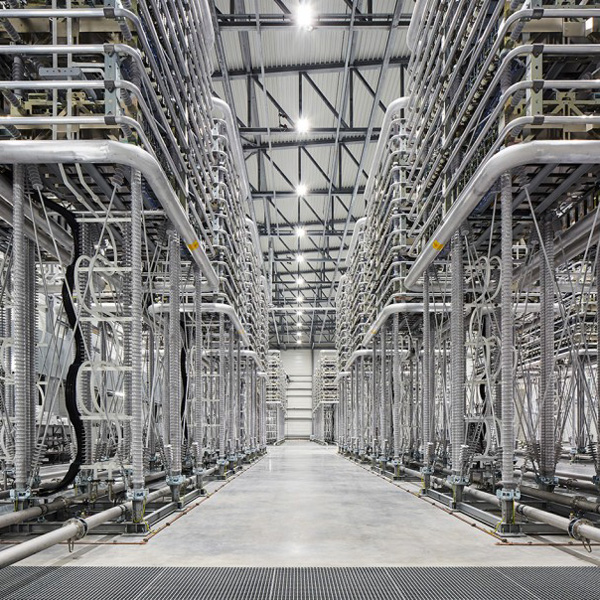CARMEL, Ind. — MISO’s future is all but certain to contain more 765-kV and HVDC transmission lines, experts predicted during a special two-day meeting of the Planning Advisory Committee last week.
“The magnitude and scope of possible system challenges point to the need for a higher-voltage, higher-capacity superhighway or backbone of either 765 kV or HVDC,” said Energy Systems Integration Group’s James Okullo, citing the volatile ramping needs, increased congestion, larger energy transfers and voltage stability issues the resource transition will bring.
He pointed out that MISO is planning for a system with 80% annual renewable penetration within 20 years.
 VSC converters | Siemens Energy
VSC converters | Siemens EnergyMultiple experts said MISO could use grid-forming voltage-sourced converter (VSC) HVDC lines and include them in the second portfolio of its long-range transmission planning (LRTP) effort. They praised VSC-HDVC’s ability to deliver power-flow control, inherent reactive power and voltage support, dynamic stability, and synthetic inertia, and its potential to provide black start system restoration.
MISO planners have said they’re not ruling out recommending a 765-kV or HVDC line in the second LRTP portfolio. (See MISO: Long-range Tx Needed for 369 GW in Interconnections.)
“VSC today is not as exotic a thing as it was 15 years ago, and with good reason,” Minnesota Power’s Christian Winter said.
Winter said VSC-HVDC is “uniquely suited for the clean energy transition” because it can move power across long distances while supplying ancillary services. He also said VSCs on the receiving end of transfers can function like dispatchable power plants and can be placed where retiring baseload generation is located.
Cornelis Plet, vice president of power system advisory at DNV, said VSC-HVDC is becoming “the technology of choice” in European countries to achieve reliability while meeting ambitious climate goals. It allows the connection of different synchronous zones and can connect remote loads and remote generation. Europe is finding HVDC technology so useful that total installed HVDC capacity will more than triple in the next decade, he said. While the continent is so far building point-to-point lines, an overlay grid of HVDC lines will realize the full benefits.
VSC has become the “workhorse” of HVDC lines, and the use of line commutated converter technology is disappearing, Plet concluded.
Brattle Group Principal Johannes Pfeifenberger said MISO is “in the best position to take advantage” of VSC-HVDC as it plans its second LRTP portfolio.
“Tranche 2 is the opportunity for MISO to get its feet wet and offers a unique opportunity for MISO to gain the necessary planning, market integration and operational experience with VSC-HVDC technology for possible larger-scale future deployments,” he said.
Pfeifenberger said Europe has discovered that VSC is “so compelling in what it can do” and has cemented itself as the dominant converter technology. He said grid planners struggle with placing a value on the resilience that HVDC can deliver. A well-placed 2,000-MW HVDC line would help Texas address its AC stability limits when it transfers power from the western portion of the state.
“It’s future-proof in a way that would be very expensive to address with AC technology,” Pfeifenberger said. He recommended that MISO adapt its markets to be able to dispatch HVDC lines to capitalize on the “incredible advantage” of alleviating congestion by controlling power flows.
American Transmission’s Bob McKee, representing MISO’s transmission owners, said the RTO’s current 240-GW interconnection queue shows the fleet transition is gearing up. He said he was delivering a “call to action from the TO sector” and encouraged MISO to “be bold” in its planning and consider all transmission solutions.
“I think Winter Storm Uri and Winter Storm Elliott are fresh in our minds, and we realize the importance of a robust transmission system,” McKee said.
McKee also said electrification “just isn’t coming; it’s already here.”
“This is our opportunity to identify a set of facilities that will fit our needs,” he said.



